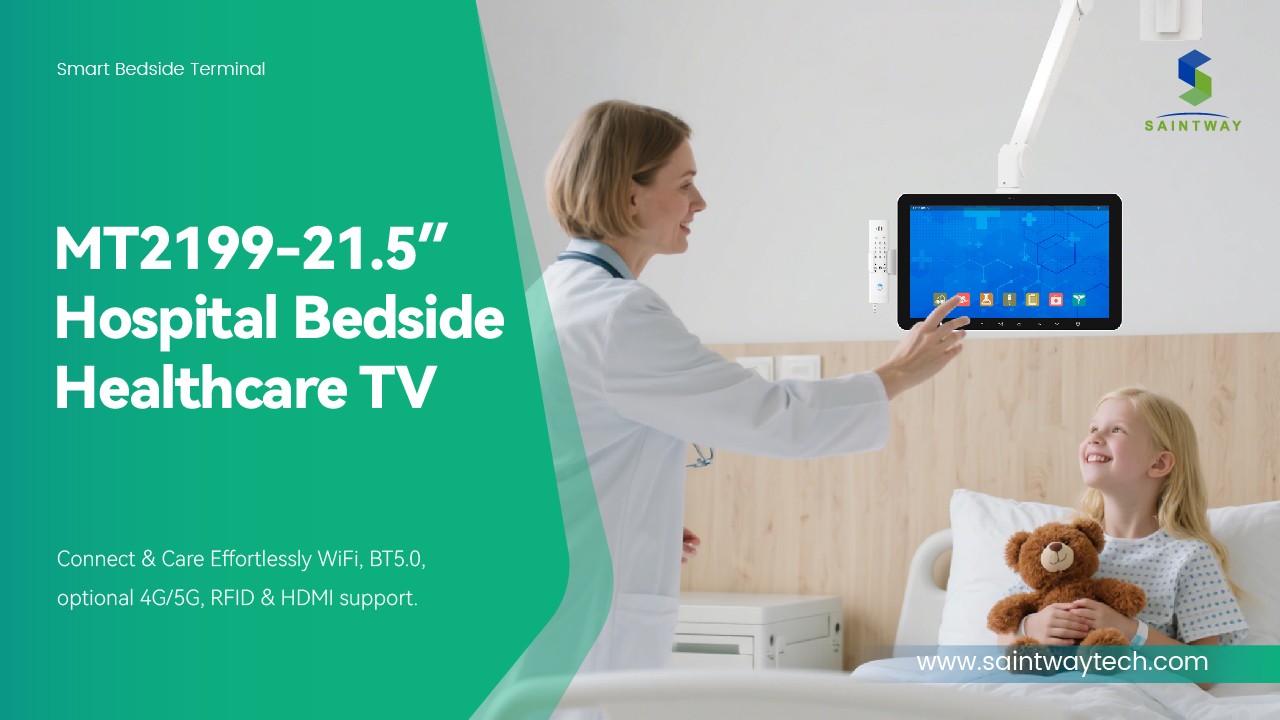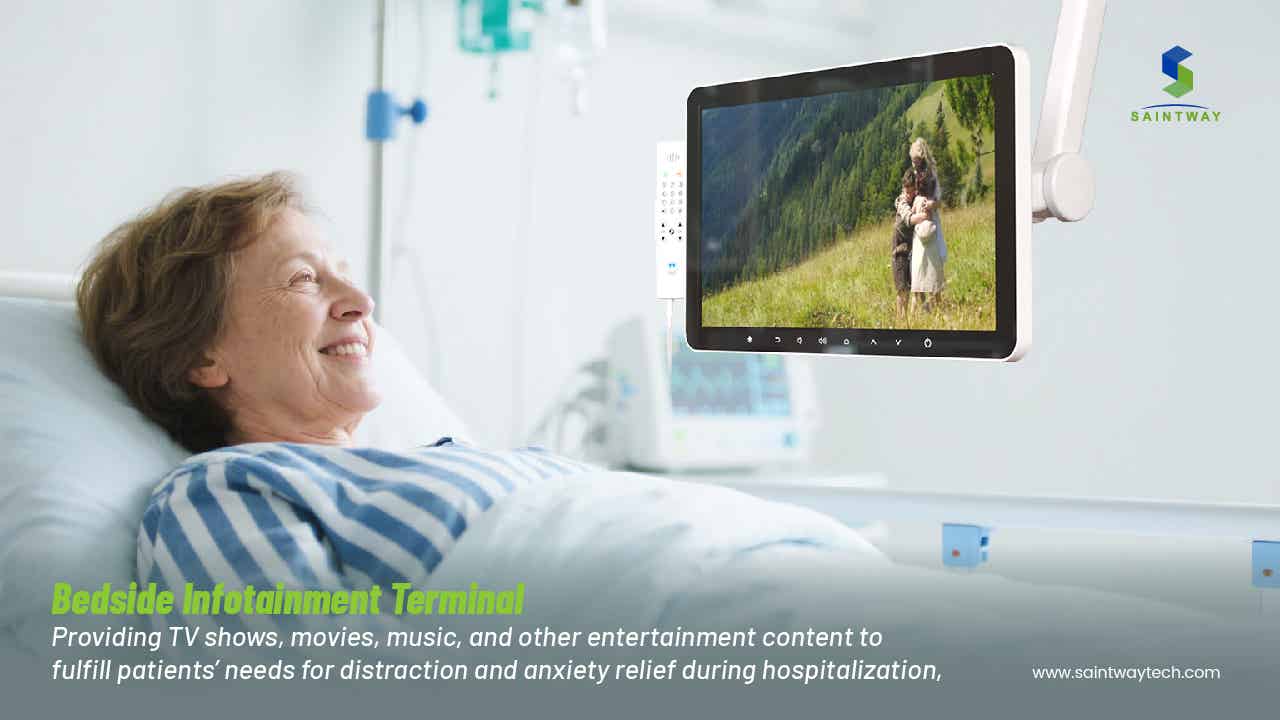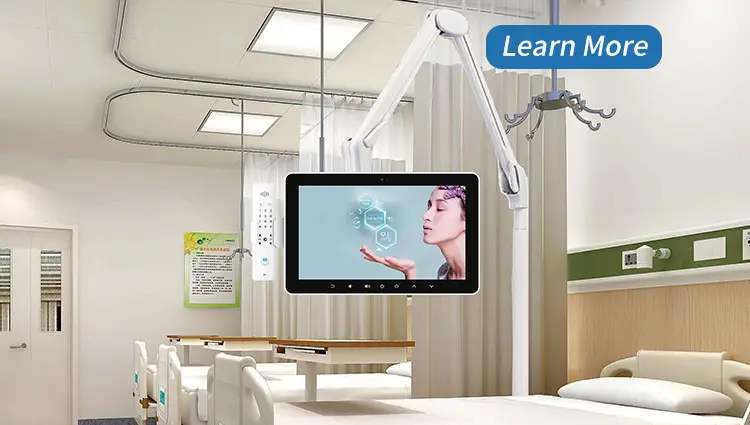- Introduction: The Era of Connected Patient Care
- What Is a Bedside Infotainment Terminal?
- Why Hospitals Are Investing in Bedside Infotainment Terminals in 2025
- Key Features to Look for in a 2025 Bedside Infotainment Terminal
- Real-World Use Cases: How Bedside Terminals Transform Care
- Operating Systems and Software Ecosystem
- Future Trends in Bedside Infotainment Terminals (2025–2030)
- How to Choose the Right Supplier
- Conclusion: Investing in Patient-Centered Digital Care
Introduction: The Era of Connected Patient Care
In 2025, hospitals and healthcare facilities are rapidly transforming into smart, patient-centered environments, where bedside infotainment terminals (BITs) play a central role. These interactive terminals combine entertainment, communication, and clinical functionality to improve both patient experience and hospital efficiency.
From streaming educational videos to enabling real-time access to medical records, the modern bedside terminal has evolved far beyond a screen—it’s a comprehensive digital hub for healthcare engagement.
This guide provides everything hospital administrators, biomedical engineers, and IT procurement managers need to know before investing in a bedside infotainment terminal in 2025. We’ll explore key features, use cases, technical specifications, and future trends that define the next generation of patient bedside technology.

What Is a Bedside Infotainment Terminal?
A Bedside Infotainment Terminal (BIT) is a touchscreen device installed near a patient’s hospital bed, designed to provide both entertainment and clinical functionalities.
Core Functions Include:
- Entertainment: TV, movies, music, and internet access.
- Communication: Video calls with family or medical staff.
- Patient Education: Interactive guides, health videos, treatment explanations.
- Clinical Integration: Access to electronic health records (EHR), meal ordering, nurse call systems, and hospital apps.
Hospitals worldwide—from large smart healthcare systems in Europe to modern private facilities in Asia—are adopting BITs as part of their digital patient engagement strategies.
Why Hospitals Are Investing in Bedside Infotainment Terminals in 2025
a. Enhanced Patient Experience
Patients in long-term or post-surgery recovery expect the same digital convenience they enjoy at home. Interactive bedside terminals make hospital stays more comfortable, reducing anxiety and improving satisfaction scores.
b. Streamlined Clinical Workflows
Integration with hospital information systems (HIS), EHRs, and nurse call systems reduces paperwork and repetitive tasks. Doctors can display medical data directly on the terminal for real-time discussion with patients.
c. Infection Control and Hygiene
Modern BITs use anti-bacterial enclosures, IP-rated waterproofing, and fanless designs, supporting the stringent infection control standards in medical environments.
d. Data-Driven Hospital Management
Each interaction generates valuable data—usage patterns, meal preferences, content engagement—that helps hospitals improve operations and customize care.
Key Features to Look for in a 2025 Bedside Infotainment Terminal
Selecting the right terminal means balancing usability, performance, and medical compliance. Here are the must-have features for 2025:
1️⃣ Medical-Grade Certification
Look for devices compliant with:
- IEC 60601-1 (medical electrical safety)
- ISO 13485 (medical device quality management)
- EN 60601-1-2 (electromagnetic compatibility)
These certifications ensure safe use in clinical environments.
2️⃣ High-Resolution, Anti-Glare Display
Patients spend hours interacting with the terminal, so visual comfort is crucial.
- Size Range: 15.6″ – 19″ is standard.
- Display Type: Full HD or higher, with wide viewing angles and anti-reflective coatings.
- Brightness: Minimum 400 nits for hospital lighting conditions.
3️⃣ Multi-Touch and Hygiene-Friendly Interface
Capacitive touchscreens with glove-friendly operation and anti-bacterial coatings ensure usability and safety in healthcare settings.
4️⃣ Modular Design and Easy Mounting
Flexible installation—wall, arm, or bedside pole mount—ensures comfort for both patients and clinicians. Some manufacturers offer VESA-compatible mounts for easy upgrades.
5️⃣ Robust Connectivity and System Integration
In 2025, a bedside terminal must integrate with multiple hospital systems:
- Wi-Fi 6 / Ethernet / Bluetooth 5.2
- Support for HL7 and FHIR protocols
- Compatibility with Android, Linux, or Windows-based hospital platforms
6️⃣ Customizable User Interface
Hospitals increasingly seek white-label solutions that align with their branding and service workflows. The interface should allow multilingual support, custom app integration, and accessibility settings.
7️⃣ Security and Data Privacy
HIPAA and GDPR compliance are non-negotiable. Look for:
- Encrypted communications
- User access control (staff vs. patient mode)
- Regular OTA (Over-the-Air) security updates
Real-World Use Cases: How Bedside Terminals Transform Care
🏥 Case 1: Smart Hospitals in South Korea
Hospitals in Seoul have integrated bedside infotainment systems connected to patient wristbands and EHRs. Patients can check lab results or request meals directly from their terminal—reducing nursing workloads by over 20%.
🏥 Case 2: Rehabilitation Centers in Germany
Facilities use bedside terminals for therapy videos and progress tracking. Patients can watch guided exercises, record sessions, and receive motivational feedback from therapists remotely.
🏥 Case 3: Pediatric Wards in the UK
Children engage with gamified interfaces and video calls, reducing stress and increasing treatment cooperation. Parents can use the same system to review medical updates and communicate with care teams.

Operating Systems and Software Ecosystem
Android-Based Systems
- Advantages: Open-source flexibility, large app ecosystem, intuitive UI.
- Ideal For: Hospitals seeking customizable and affordable solutions.
Linux-Based Systems
- Advantages: High security, reliability, and low maintenance cost.
- Ideal For: Hospitals focused on long-term stability and data protection.
Windows-Based Systems
- Advantages: Easy integration with legacy hospital software and EHRs.
- Ideal For: Institutions using Windows-based healthcare IT infrastructures.
Future Trends in Bedside Infotainment Terminals (2025–2030)
🧠 AI-Driven Personalization
Artificial intelligence will enable terminals to recommend educational content, track recovery progress, and offer emotional well-being tools.
☁️ Cloud-Based Integration
Hospitals are moving toward centralized management systems that update, monitor, and analyze all terminals remotely.
🎤 Voice Control and Accessibility
Voice-activated commands and accessibility features like text-to-speech will make BITs inclusive for elderly and disabled patients.
🔋 Energy Efficiency and Sustainability
Low-power components and recyclable enclosures are becoming a key purchasing factor as hospitals pursue green certifications.
How to Choose the Right Supplier
✔ Check Medical Compliance
Always verify certifications like IEC 60601-1, ISO 13485, and RoHS.
✔ Evaluate Support and Warranty
Choose vendors offering long-term OS updates, remote management tools, and on-site service options.
✔ Review Integration Capabilities
Request demonstrations of EHR connectivity, HIS integration, and third-party app compatibility.
✔ Look for Proven Experience
Suppliers specializing in medical-grade smart terminals, such as Saintway, Barco, and Advantech, typically offer the most reliable solutions for clinical environments.
Conclusion: Investing in Patient-Centered Digital Care
The bedside infotainment terminal has become a cornerstone of modern hospital digital transformation. It bridges the gap between comfort and care, empowering patients with knowledge while streamlining medical operations.
In 2025, choosing the right BIT isn’t just a procurement decision—it’s a strategic investment in patient engagement, operational efficiency, and future-ready healthcare.


